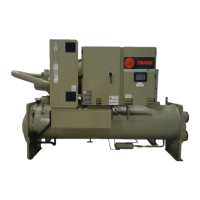RTHD-SVX01K-EN 51
Operating Principles
This section describes the overall operating principles of
the Optimus™ water chiller.
General
Optimus™ units are single-compressor water-cooled
liquid chillers. These units are equipped with unit-
mounted starter/control panels.
The basic components are:
• Unit-mounted panel containing Symbio™ 800
controller and input/output LLIDs
• Helical-rotary compressor
•Evaporator
• Electronic expansion valve
• Water-cooled condenser with integral subcooler
• Oil supply system
• Oil cooler (application dependent)
• Related interconnecting piping
• AFD (optional)
Refrigeration Cycle
The refrigeration cycle can be described using the
pressure-enthalpy diagram shown in Figure 22. Key State
Points are indicated on the figure and are referenced in the
discussion following.
The Optimus™ chiller makes use of a shell-and-tube
evaporator design with refrigerant evaporating on the
shell side and water flowing inside tubes having enhanced
surfaces.Refrigerant vapor leaves the evaporator as
saturated vapor (State Pt. 1).
The refrigerant vapor generated in the evaporator flows to
the suction end of the compressor. The compressor is a
twin-rotor helical rotary type. The refrigerant flows across
the motor, providing the necessary cooling, then enters
the compression chamber. Refrigerant is compressed in
the compressor to discharge pressure conditions.
Simultaneously, lubricant is injected into the compressor.
An oil management system provides an almost oil-free
refrigerant to the shells to maximize heat transfer
performance, while providing lubrication and rotor
sealing to the compressor. The lubrication system ensures
long compressor life and contributes to quiet operation.
Immediately following the compression process the
lubricant and refrigerant are effectively divided using an
oil separator.
The oil-free refrigerant vapor enters the condenser at State
Pt. 2. Condensing is accomplished in a shell-and-tube heat
exchanger where refrigerant is condensed on the shell
side and water flows internally in the tubes. Cooling tower
water, circulating through the condenser tubes, absorbs
heat from this refrigerant and condenses it.
As the refrigerant leaves the bottom of the condenser
(State Pt. 3), it enters an integral subcooler where it is
subcooled before traveling to the electronic expansion
valve (State Pt. 4). The pressure drop created by the
expansion process vaporizes a portion of the liquid
refrigerant.
The resulting mixture of liquid and gaseous refrigerant
then enters the Evaporator Distribution system (State Pt.
5). The flash gas from the expansion process is internally
routed to compressor suction, and while the liquid
refrigerant is distributed over the tube bundle in the
evaporator.
Refrigeration Circuits
Each unit has a single refrigerant circuit. Each refrigerant
circuit includes compressor suction and discharge service
valves, removable core filter, charging port, and sight
glass. An electronically controlled expansion valve is
provided to maintain variable capacity modulation over
the entire building load and maintain proper refrigerant
flow.
Compressor and Motor
Unit is equipped with a semi-hermetic, direct-drive, 3600
rpm 60 Hz (3000 rpm 50 Hz) rotary compressors that
includes a capacity control slide valve, oil sump heater,
and differential pressure refrigerant oil flow system.
Optional AFD provides capacity control with lower speeds.
Four pressure-lubricated rolling element bearing groups
support the rotary assembly. Motor is suction gas-cooled,
hermetically sealed, two-pole squirrel cage induction
motor.
Evaporator and Condenser
Heat exchangers are shell and tube design. Standard tubes
are externally finned, internally enhanced seamless
Figure 22. Pressure/enthalpy curve
Pressure
Enthalpy
Liquid
1
3
5
2
4

